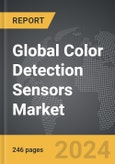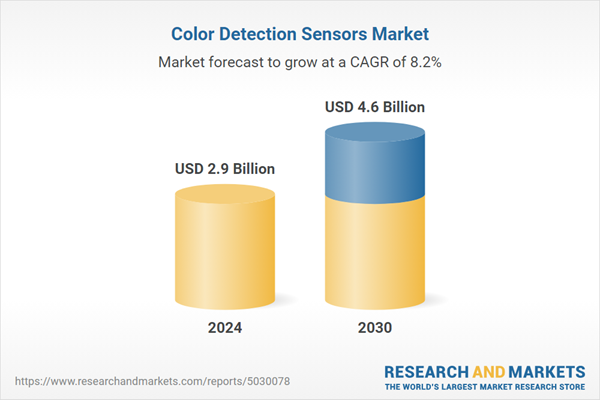The global market for Color Detection Sensors was valued at US$2.9 Billion in 2024 and is projected to reach US$4.6 Billion by 2030, growing at a CAGR of 8.2% from 2024 to 2030. This comprehensive report provides an in-depth analysis of market trends, drivers, and forecasts, helping you make informed business decisions.
Global Color Detection Sensors Market - Key Trends and Drivers Summarized
What Are Color Detection Sensors and How Do They Operate?
Color detection sensors are advanced devices that are used to identify and differentiate between various colors by analyzing the wavelengths of light reflected from a surface. These sensors function by emitting light through a source, such as an LED, and then detecting the light reflected off an object using photodetectors. The reflected light is then analyzed to determine the specific color based on the wavelength and intensity of the light received. Depending on the type of sensor, they can detect basic colors like red, green, and blue (RGB) or even more complex color variations. Color detection sensors are commonly used in a variety of industries where accuracy and consistency in color recognition are critical. They play a pivotal role in quality control, production automation, and color sorting processes, enabling businesses to ensure that products meet exacting color specifications. Their use has grown significantly across sectors that demand precision, such as automotive manufacturing, packaging, printing, and textile production, due to their ability to operate efficiently and consistently in high-speed production environments.How Are Color Detection Sensors Transforming Industries and Applications?
Color detection sensors have become an integral part of many industrial processes, reshaping how businesses approach quality control, production automation, and customization. In the automotive industry, for example, color sensors are used to ensure that parts and paint coatings match precisely, improving the visual quality and consistency of vehicles. This is critical in a sector where brand identity and customer satisfaction are closely tied to aesthetics. Similarly, in the packaging industry, color detection sensors help verify that packaging materials are produced with the correct colors, ensuring brand consistency and reducing waste due to color mismatches. These sensors are also widely used in food and beverage production, where they are used to detect subtle color changes that indicate ripeness, spoilage, or contamination. Moreover, color detection sensors are now being applied in areas like robotics and AI-driven systems, where accurate color recognition is essential for automated sorting and handling. For example, in waste management, color sensors are used in recycling systems to identify and sort materials based on color, improving efficiency and sustainability efforts. The rise of smart technologies and Industry 4.0 has further integrated color detection sensors into the wider spectrum of automation and robotics, making them a key component in intelligent manufacturing systems. Their ability to detect even slight color variations quickly and accurately has made them indispensable for enhancing operational efficiency and product quality across multiple industries.What Technologies and Innovations Are Driving the Color Detection Sensor Market?
The advancements in sensor technology and the integration of artificial intelligence (AI) and machine learning (ML) are significantly enhancing the capabilities of color detection sensors. One of the major innovations is the development of multispectral sensors, which can detect a broader range of color wavelengths and provide more precise color differentiation. These sensors are particularly useful in applications requiring fine color distinctions, such as high-end printing, pharmaceutical production, and food processing. Another key technological advancement is the increasing miniaturization of sensors, which makes them more versatile and easier to integrate into compact devices. This is especially relevant in industries like consumer electronics and robotics, where space constraints are a major consideration. Artificial intelligence is also playing a critical role in the evolution of color detection sensors. By integrating AI algorithms, these sensors can now learn and adapt to new colors or changing environmental conditions, improving their accuracy in dynamic or challenging environments. This capability is being leveraged in smart manufacturing systems where AI-enhanced color detection can lead to predictive maintenance and error correction in real-time, preventing defects and reducing downtime. Additionally, the growing adoption of wireless and IoT technologies is enabling color detection sensors to be integrated into larger networks, allowing for remote monitoring and control in automated production lines.What Is Driving the Growth in the Color Detection Sensors Market?
The growth in the color detection sensors market is driven by several factors, including increasing automation in manufacturing, rising demand for high-quality products, and technological advancements in sensor accuracy and functionality. The widespread adoption of automation and smart manufacturing technologies across various industries, particularly in automotive, packaging, and electronics, is creating a high demand for color detection sensors that can maintain consistency and quality in high-speed production lines. Additionally, the shift toward customized and personalized products is further driving the need for precise color matching solutions, particularly in industries like fashion, printing, and consumer goods. Moreover, regulatory requirements and rising consumer expectations for product quality are pushing manufacturers to adopt more sophisticated quality control technologies, including color detection sensors. The demand for advanced sensors that can detect subtle color variations in food, beverages, and pharmaceuticals is also growing, as safety and quality control become critical in these sectors. Innovations in AI, machine learning, and IoT connectivity are enhancing the performance of color detection sensors, enabling them to be integrated into more complex and intelligent production systems. As these technologies continue to evolve, they are expanding the application of color detection sensors into emerging areas such as robotics, recycling, and smart city infrastructure, further fueling market growth. The increasing emphasis on reducing waste and improving sustainability is another major driver, as color detection sensors play a key role in ensuring efficiency and accuracy in material sorting and recycling processes. Together, these factors are shaping a robust and expanding market for color detection sensors across the globe.Report Scope
The report analyzes the Color Detection Sensors market, presented in terms of market value (US$ Thousand). The analysis covers the key segments and geographic regions outlined below.Segments
Type (Color Sensors, Luminescence Sensors, Contrast Sensors, RGB Sensors, Brightness Sensors); End-Use (Packaging & Printing, Textiles, Food & Beverage, Chemicals, Other End-Uses).Geographic Regions/Countries
World; United States; Canada; Japan; China; Europe (France; Germany; Italy; United Kingdom; Spain; Russia; and Rest of Europe); Asia-Pacific (Australia; India; South Korea; and Rest of Asia-Pacific); Latin America (Argentina; Brazil; Mexico; and Rest of Latin America); Middle East (Iran; Israel; Saudi Arabia; United Arab Emirates; and Rest of Middle East); and Africa.Key Insights:
- Market Growth: Understand the significant growth trajectory of the Color Sensors segment, which is expected to reach US$1.3 Billion by 2030 with a CAGR of a 8.6%. The Luminescence Sensors segment is also set to grow at 8.5% CAGR over the analysis period.
- Regional Analysis: Gain insights into the U.S. market, valued at $735.0 Million in 2024, and China, forecasted to grow at an impressive 11.9% CAGR to reach $1.1 Billion by 2030. Discover growth trends in other key regions, including Japan, Canada, Germany, and the Asia-Pacific.
Report Features:
- Comprehensive Market Data: Independent analysis of annual sales and market forecasts in US$ Million from 2024 to 2030.
- In-Depth Regional Analysis: Detailed insights into key markets, including the U.S., China, Japan, Canada, Europe, Asia-Pacific, Latin America, Middle East, and Africa.
- Company Profiles: Coverage of major players such as ams AG, ASTECH Angewandte Sensortechnik GmbH, Balluff GmbH, Banner Engineering Corporation, Baumer GmbH and more.
- Complimentary Updates: Receive free report updates for one year to keep you informed of the latest market developments.
Why You Should Buy This Report:
- Detailed Market Analysis: Access a thorough analysis of the Global Color Detection Sensors Market, covering all major geographic regions and market segments.
- Competitive Insights: Get an overview of the competitive landscape, including the market presence of major players across different geographies.
- Future Trends and Drivers: Understand the key trends and drivers shaping the future of the Global Color Detection Sensors Market.
- Actionable Insights: Benefit from actionable insights that can help you identify new revenue opportunities and make strategic business decisions.
Key Questions Answered:
- How is the Global Color Detection Sensors Market expected to evolve by 2030?
- What are the main drivers and restraints affecting the market?
- Which market segments will grow the most over the forecast period?
- How will market shares for different regions and segments change by 2030?
- Who are the leading players in the market, and what are their prospects?
Some of the 46 major companies featured in this Color Detection Sensors market report include:
- ams AG
- ASTECH Angewandte Sensortechnik GmbH
- Balluff GmbH
- Banner Engineering Corporation
- Baumer GmbH
- Datalogic SpA
- EMX Industries, Inc.
- Hamamatsu Photonics KK
- Hans Turck GmbH & Co. KG
- IDEC Corporation
- Keyence Corporation
- Micro-Epsilon Messtechnik GmbH & Co. KG
- NIDEC-SHIMPO CORPORATION
- Omron Corporation
- Panasonic Corporation
- Pepperl+Fuchs GmbH
- Rockwell Automation, Inc.
- SensoPart Industriesensorik GmbH
- Sensor Instruments Entwicklungs- und Vertriebs GmbH
- SICK AG
Table of Contents
I. METHODOLOGYII. EXECUTIVE SUMMARY2. FOCUS ON SELECT PLAYERSIII. MARKET ANALYSISSOUTH KOREAREST OF ASIA-PACIFICARGENTINABRAZILMEXICOREST OF LATIN AMERICAIRANISRAELSAUDI ARABIAUNITED ARAB EMIRATESREST OF MIDDLE EASTIV. COMPETITION
1. MARKET OVERVIEW
3. MARKET TRENDS & DRIVERS
4. GLOBAL MARKET PERSPECTIVE
UNITED STATES
CANADA
JAPAN
CHINA
EUROPE
FRANCE
GERMANY
ITALY
UNITED KINGDOM
SPAIN
RUSSIA
REST OF EUROPE
ASIA-PACIFIC
AUSTRALIA
INDIA
LATIN AMERICA
MIDDLE EAST
AFRICA
Companies Mentioned (Partial List)
A selection of companies mentioned in this report includes, but is not limited to:
- ams AG
- ASTECH Angewandte Sensortechnik GmbH
- Balluff GmbH
- Banner Engineering Corporation
- Baumer GmbH
- Datalogic SpA
- EMX Industries, Inc.
- Hamamatsu Photonics KK
- Hans Turck GmbH & Co. KG
- IDEC Corporation
- Keyence Corporation
- Micro-Epsilon Messtechnik GmbH & Co. KG
- NIDEC-SHIMPO CORPORATION
- Omron Corporation
- Panasonic Corporation
- Pepperl+Fuchs GmbH
- Rockwell Automation, Inc.
- SensoPart Industriesensorik GmbH
- Sensor Instruments Entwicklungs- und Vertriebs GmbH
- SICK AG
Table Information
| Report Attribute | Details |
|---|---|
| No. of Pages | 246 |
| Published | April 2025 |
| Forecast Period | 2024 - 2030 |
| Estimated Market Value ( USD | $ 2.9 Billion |
| Forecasted Market Value ( USD | $ 4.6 Billion |
| Compound Annual Growth Rate | 8.2% |
| Regions Covered | Global |









